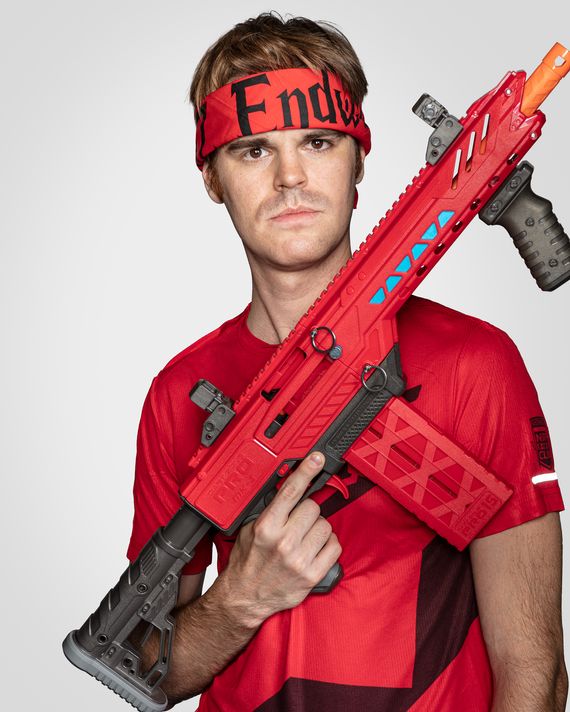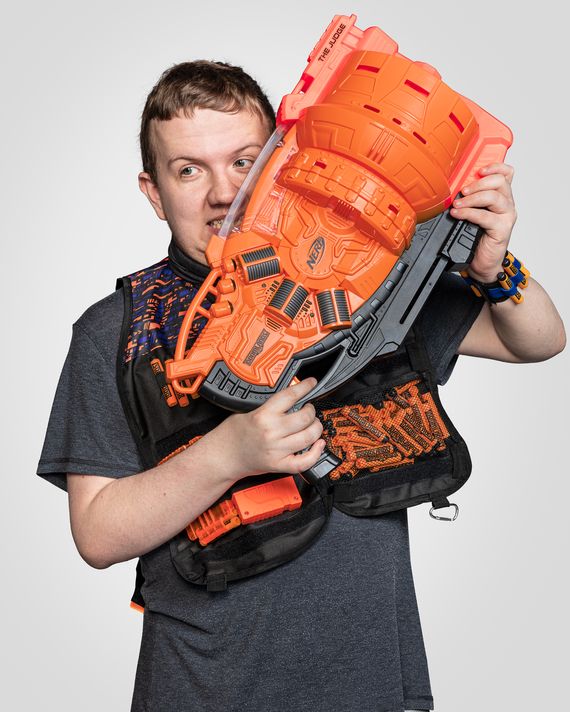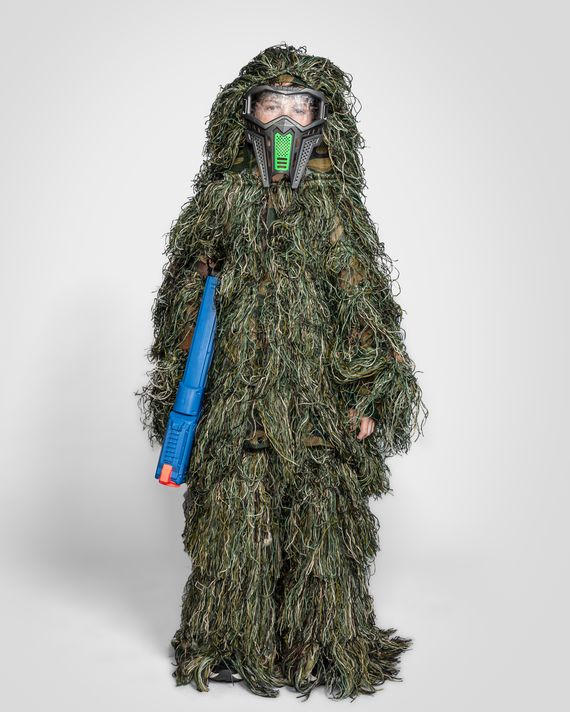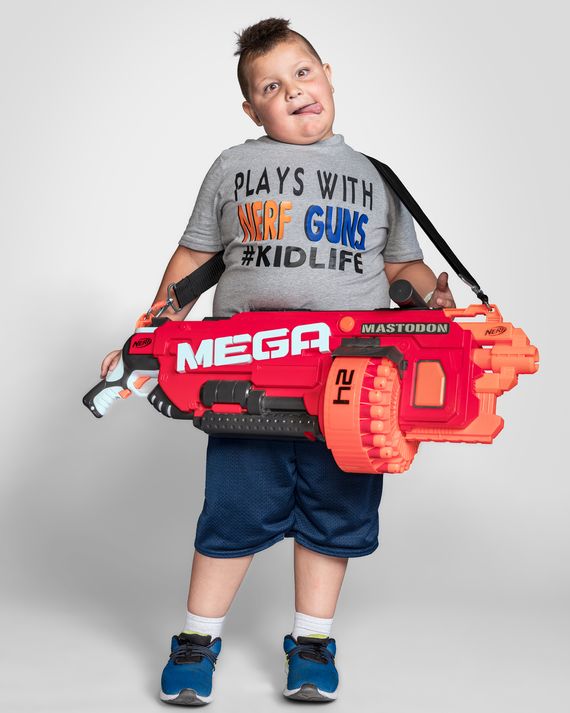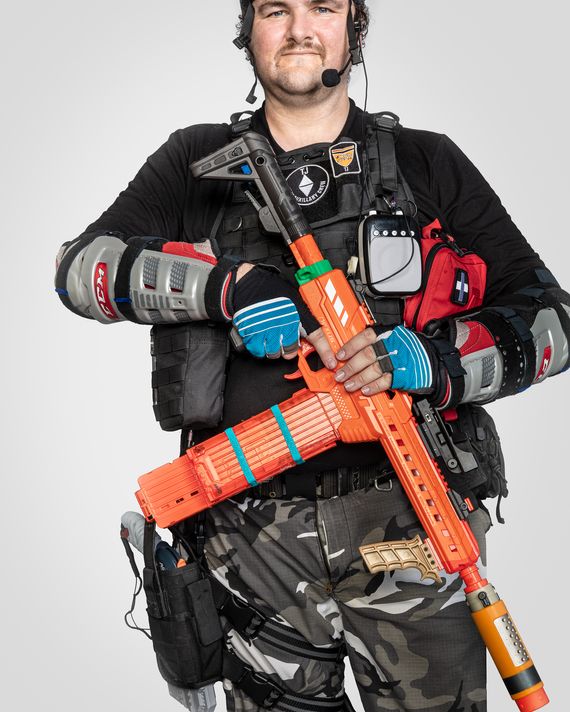
This article was featured in One Great Story, New York’s reading recommendation newsletter. Sign up here to get it nightly.
One hot morning at a park in Atlanta, a few dozen members of the SouthEast Nerf Club gathered around folding tables, eyeing each other’s specced-up toy guns. Some they’d built from scratch; others came out of the box fully loaded. A mountain-shaped man unzipped a rifle case to reveal two AR15 look-alikes made of cheery blue-and-orange plastic. A woman with tattooed thighs cradled a red, white, and blue carbine with “Daddy’s Little Monster” printed on the receiver. A scrawny young man in camo pants and a tactical vest showed off the working rifle scope he’d attached to the barrel of his plaything. Soon, the Nerfers would disperse throughout the park, darting out from behind trees like commandos to thwack each other with foam ammunition at 200 feet per second.
The club has held Nerf battles around the city for years, sometimes drawing hundreds of participants: fathers and sons, college students, men in their 20s, women who want to flirt with men in their 20s. Today’s gathering had been called by the group’s unofficial leader, Drac Thalassa, a light-footed, lanky 29-year-old who goes by Lord Draconical and has made a living out of Nerf. On YouTube, where his videos have been viewed more than 339 million times, Drac reviews blasters (as they are known) and teaches his viewers how to make them more powerful. He’s also a paid consultant for blaster manufacturers and coordinates Nerf battles considerably larger than this one. In June, he helped organize an event at AT&T Stadium in Arlington, Texas — the home of the Dallas Cowboys — that drew 1,300 participants.
The goofy gunplay on display at Drac’s events blends childishness and combat in a way that seems distinctly, and sometimes disconcertingly, American. In the Atlanta park, he spun a plastic revolver around his finger like a sharpshooter in an old western. “It’s time to go to war,” he said.
As Drac reloaded magazines, a kid wandered over from a nearby birthday party and stared. “Are you Lord Drac?” he asked, his voice thick with wonder. “I’ve been watching your videos for three years.” Others in the park weren’t sure what to make of the scene. A man walking by with his daughter leaned in to examine a fluorescent pump-action blaster. “I don’t think those are for kids, honey,” his wife said tentatively. Her confusion makes sense. The Nerf warriors exist in some zone between child’s play and adult LARP. Drac scouts supplies from the toy aisles at Walmart; he also makes players wear eye protection, since the modified blasters could do real damage. “At some point,” a dedicated Nerfer told me, “it’s a toy but not a toy.”
For most of history, the makers of toy guns tried to make them look as real as possible. Play was rehearsal for adulthood, and the toys’ design mimicked what soldiers and cops carried. In the 1960s, Daisy, the maker of the famous Red Ryder BB rifle, released its Spittin’ Image line: “air guns patterned, to the smallest detail, after famous firearms.”
Rising crime rates drove a temporary reconsideration. In 1987, Burbank became the first city in America to ban the sale of realistic-looking toy guns after an armed man burst onto the set of a live news broadcast and forced a reporter to read a rambling statement about clones, aliens, and the CIA. (His weapon turned out to be a pellet gun.) It was the beginning of a national crackdown on look-alikes, which were often used to commit real crimes and sometimes resulted in high-profile incidents of cops shooting children to death. Communities held toy buybacks, and the largest toy retailers stopped selling fake firearms. In 1992, the federal government issued guidance for how such toys should look: They had to have orange tips, or be entirely white, bright red, orange, yellow, green, blue, pink, or purple.
That same year, the first Nerf-branded foam-dart blaster hit the market. The Sharpshooter had a cartoonishly bulbous form molded out of green and blue plastic, with blaze-orange accents. Sure, you pulled the trigger to fire ammunition, but it hardly resembled a real weapon. Over the next decade, designers at Nerf, a division of Hasbro, came up with fanciful models shaped like bats, piranhas, and spiders. What they didn’t look like were weapons of war.
The blasters’ harmlessness might have been a selling point in the gun-shy 1990s, but after 9/11, as the wars in Afghanistan and Iraq ramped up, a Special Operations aesthetic seeped into pop culture. In 2004, after the federal assault-weapons ban expired, Americans bought millions of AR-style rifles, and first-person shooters became the dominant mode in video games. Hasbro sensed a market opportunity. In 2006, the company released the Longshot, a Nerf version of a sniper rifle, with a design that mimicked reality. It was the first blaster to come with reloadable magazines, which kids would fill with ammo and snap into place. The tactical rail on its barrel was designed to fit additional accessories, like sights, scopes, and shields, and foldout bipod legs added stability. The Longshot was wildly popular and was rereleased six times. According to a comprehensive Nerf fan site, it has likely had the longest shelf availability of any blaster.
Second Amendment types like to joke that the AR15 is a gun guy’s equivalent of a Barbie doll: There are lots of exciting accessories to buy. The same could be said of toy weapons’ platforms. In the decade after the Longshot’s release — a period in which some 113,000 American students experienced gun violence at school, according to a database maintained by the Washington Post — its sales helped Nerf revenue grow tenfold, to $400 million.
In college, first at Georgia Southern and later at Georgia Tech, Drac got obsessed with the Humans vs. Zombies fad — campus-scale games of tag using foam blasters. “It was a different world in 2010,” he said. “You could jump out of a tree and point a blaster at a cop and not get murdered.” An inveterate explainer, Drac had a YouTube channel full of instructional videos (how to make retractable vampire fangs; how to prepare beef tenderloin), and he added Nerf tinkering to his repertoire. The clips showed viewers how to take Hasbro’s new wares and enhance them, adjusting and replacing parts to make darts fly faster, farther, and more accurately. Drac’s timing was opportune. The maker movement and cosplay culture were dovetailing with 1990s nostalgia, and some of his videos amassed hundreds of thousands of views. “All of a sudden, I’m the Nerf guy,” he told me.
In 2015, Hasbro blessed the modder community by inviting Drac to its headquarters in Pawtucket, Rhode Island. “I was thrilled,” Drac said. “I was the first person from my world to crack the safe.” His YouTube videos never showed his face, which lent him an air of intrigue. (Fans would speculate about what he was hiding. Disfigurement? Meth teeth? Was he, perhaps, too handsome?) To keep the mystique alive, Drac wore a suit and an Iron Man mask for his photo ops at Hasbro. “They were a little confused,” he said. But Hasbro’s executives let him handle some prototypes, and he offered some criticism. “I’m providing what I know now is, like, corporate-level consulting for marketing and design completely for free, because I’m this young, naïve, excited YouTube boy,” he told me.
The informal and unpaid relationship continued for years. Drac assumed that the free labor was building toward a job offer, but after Hasbro made it clear that it wouldn’t hire him unless it could control his content, he broke off to create his own blaster business. He bought 3-D printers and hired friends to design and test aftermarket upgrades: a more ergonomic grip; a shim that keeps a cheap stock from collapsing; a precision-made flywheel cage; tougher springs. His priciest bespoke blaster now sells for $600.
Over time, Drac also started paying more attention to real firearms. At first, his interest was academic; he wanted to improve his blaster designs, and he figured the people who knew the most about foregrips and triggers weren’t making toys. At a trade show in Atlanta, he felt like an oddity among the tough-guy crowd. “I’m not your average danger boy,” he told me. But he met John Willis, the grizzled “Versace of Velcro,” who makes custom tactical gear for Special Forces operators, and convinced him to collaborate on new products for the blaster market. Drac has since bought a few AR-style rifles and signed up for training sessions, including a simulated combat class (tagline: “We teach good people to kill bad people”) and a course with a former Navy SEAL.
Drac tries to be careful to not let too much of his real steel training seep into the foam world. At Nerf events, he tends to wear a T-shirt and shorts, leaving the cosplay to others. In their tactical vests and helmets and lace-up boots, some players resemble video-game snipers or combat veterans; others prefer a sillier, superhero-inflected look. Nerf faces a growing number of competitors, like the New Jersey–based Dart Zone, that are doubling down on the tactical aesthetic. One Dart Zone model, the Max Stryker, a sleek sniper rifle, is sold with two “tactical sights,” a “tactical scope,” a “tactical stock,” and a “detachable elongated muzzle brake,” along with ammo, clips, and other accessories. (Drac, like practically everyone I spoke to, still uses “Nerf gun” as a generic term for any blaster, no matter who makes it.)
In August 2020, Isaiah Elliott, a 12-year-old Black boy in Colorado Springs, Colorado, signed on to his third day of Zoom school and began to fiddle with a slime-green blaster from the Umarex Zombie Hunter line. An art teacher emailed his mother, Dani, to say that she’d have to notify the principal. Both Dani and her husband, Curtis, were at work; she promised to talk to Isaiah about not playing with toys during class. She thought the matter was resolved until a few hours later, when the school called her to say that the police were on the way to her house for a health-and-wellness check, just in case the gun was real.
Dani panicked. Isaiah was home alone and the cops had been told her son was potentially armed. She called Isaiah and told him to put the toy away, lock the doors, stay away from the windows, keep your hands visible. “He’s like, ‘Mommy, you’re scaring me, you’re scaring me,’” Dani told me. “And I’m like, ‘You know, I’m scared myself.’”
Curtis got back to the house just before the police arrived. He listened to them lecture his son and tell him that they could arrest him for interfering with an educational institution. The next day, Isaiah was suspended from school for five days. Dani and Isaiah later testified about the experience at the state capitol. His school record has been wiped clean and the school district, which formally apologized, has instituted diversity and inclusion training.
At the park in Atlanta, I stood under a shade tent talking with a few noncombatants, including two of the three Black attendees. One of them, a woman in her 20s who is married to a dedicated Nerfer, described the pegboard of blasters in her work-from-home office. She hadn’t given them a second thought until a colleague in a Zoom meeting teased her. “People were like, ‘Are you preparing for the zombie apocalypse?’” she said. “I had no idea how sensitive this was.”
Everyone agreed that it was getting trickier to keep an aesthetic distinction between real and fake guns as the spread of 3-D printing has made it easy to create fun-looking firearms. In July, a Utah company began selling a kit that let users modify Glocks to look like they were made out of Legos, boasting, “This is just one small way to break the rhetoric from Anti-Gun folks and draw attention to the fact that the shooting sports are SUPER FUN!” (After Lego threatened legal action, the company desisted.) There had been some recent drama on the Nerf sub-Reddit, where a poster had shared a photo of real guns that had been painted to look just like the brand’s blasters, logo included.
Drac was shooting that day with a prototype of the Sabre Construct M20, which had arrived from a boutique blaster shop in Singapore and was constructed out of a high-performance plastic called Delrin. He had added some neon tape because he didn’t think its orange tip was visible enough. It still looked unnervingly real. “What if that goes to a Black kid, and the cops take him out?” the young woman said.
Out on the field, Drac’s crew of misfits were absorbed in their ersatz version of tag. A guy clutching a plastic sword in each hand dashed wildly across the field in an inexplicable blitz attack and was immediately pelted with dozens of darts. He fell to his knees, smiling, then leapt back up to play another round in a game where violence has no impact, and no one ever gets hurt.


